Amman is the capital of Jordan. Amman is known for its blend of ancient and contemporary and serves as Jordan’s political, cultural, and economic hub.
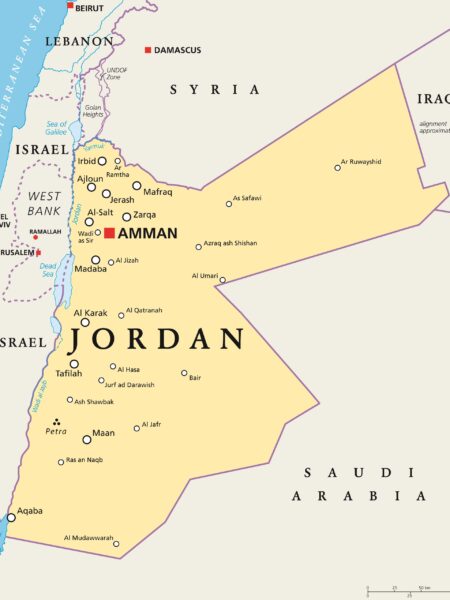
Amman is one of the oldest continuously inhabited cities in the world, with evidence of settlement dating back to the Neolithic period. The city was initially built on seven hills, similar to Rome, although it has since expanded to cover more than 19 hills.
Where is Amman?
Amman is situated in the north-central region of Jordan. The city lies at an elevation ranging from 700 to 1,100 meters (2,300 to 3,600 feet) above sea level. Amman is in the Middle East, a region that bridges Western Asia and Eastern Africa. Specifically, Amman lies at approximately 31.95 degrees North latitude and 35.91 degrees East longitude.
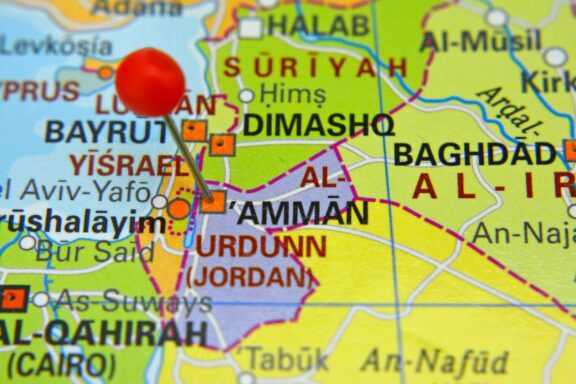
The city is surrounded by neighboring countries such as Syria to the north, Iraq to the east, Saudi Arabia to the southeast, and Israel and Palestine to the west, and it is approximately 48 kilometers (30 miles) from the Dead Sea and about 60 kilometers (37 miles) from the Jordanian-Syrian border. Its proximity to these countries makes Amman a strategically important location in regional geopolitics.
History of Amman
Amman started as “Rabbath Ammon,” a city belonging to the Ammonites around 1200 BCE. The Ammonites were known for their Semitic language and cultural practices. The city served as their capital, a fortified center for trade and administrative activities.
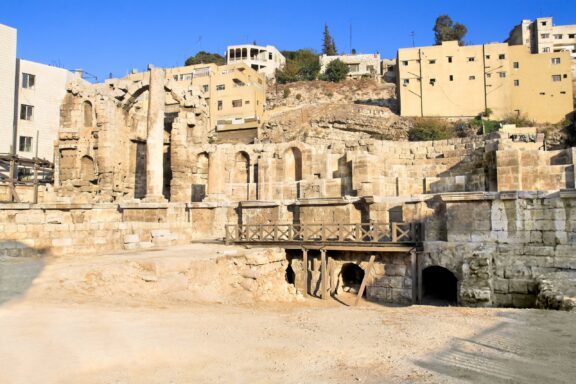
After the Ammonite Period, during the Roman Era, Amman was renamed “Philadelphia” after its conquest by Ptolemy II Philadelphus in the 3rd century BCE. It became an essential part of the Decapolis, a league of ten cities that had special status under Roman rule. This era saw the construction of significant structures like the Roman Theater and the Nymphaeum, which were central to public life.
Later, in the 7th century, after the Islamic conquest, Amman reverted to its original name and became part of the expanding Islamic empire.
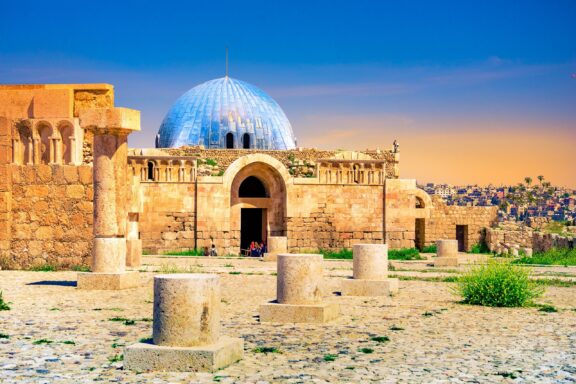
Under the Umayyad Caliphate, the city enjoyed growth and prosperity. The Abbasid period followed, although Amman seemed to decline significantly during this time, becoming more of a rural settlement.
During Ottoman rule, starting in the 16th century, Amman experienced a phase of stagnation. It was a small, somewhat overlooked town until the late Ottoman period. The construction of the Hejaz Railway in the early 20th century brought new economic opportunities and led to modest growth.
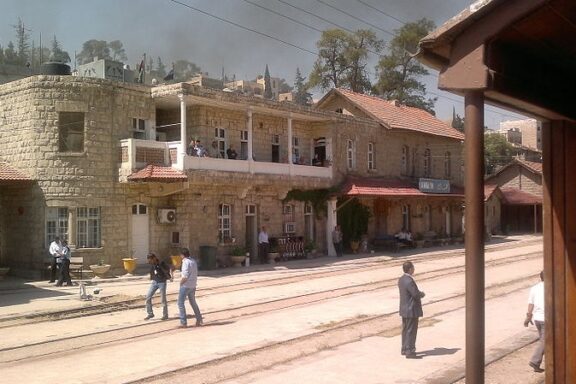
The modern period, after the 20th century, transformed Amman from a small town into a bustling capital. When Transjordan gained its independence, Amman became the political and administrative center. Waves of refugees from various regional conflicts, such as the 1948 Palestinian exodus and the Iraq wars, contributed to rapid population growth and cultural diversity.
Over the centuries, different periods have left an indelible mark on Amman, each contributing unique elements to the city’s complex tapestry of history, culture, and architecture. Today, Amman is a multifaceted city where ancient history coexists with modern life.
Features of Amman
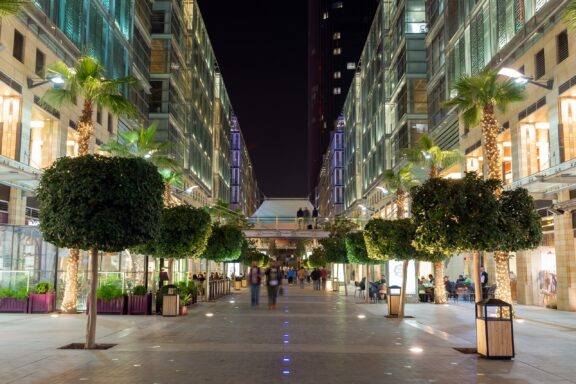
Amman captivates visitors with contrasts and variety, where the pulse of modern life beats in sync with the rhythms of a rich and ancient history. As you stroll through the city, you’ll find a fascinating contrast between ancient history and contemporary living. Architectural remnants of bygone eras deviate from the gleaming skyscrapers and modern shopping malls.
The cityscape is a panorama of white limestone buildings, giving Amman its characteristic appearance. The cultural diversity is palpable, reflecting its storied past and the successive waves of immigrants and refugees who have made the city its home.
Geography and Climate
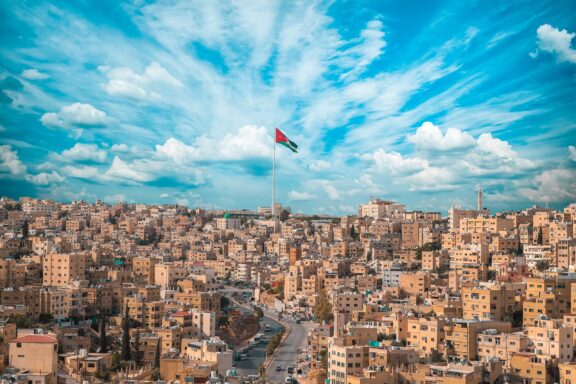
Amman’s topography is marked by its hilly landscape, which substantially influences its layout and development. The city sprawls over numerous hills, giving rise to an intricate network of winding streets and alleys.
The high elevation leads to a relatively mild climate compared to other Middle Eastern cities. Summers are hot but bearable, with temperatures ranging from 20 to 33 °C (68 to 91 °F).
Winters are generally cool, and rainfall is most common between November and March. Snowfall occurs occasionally, adding a picturesque layer to the city’s architecture.
Population
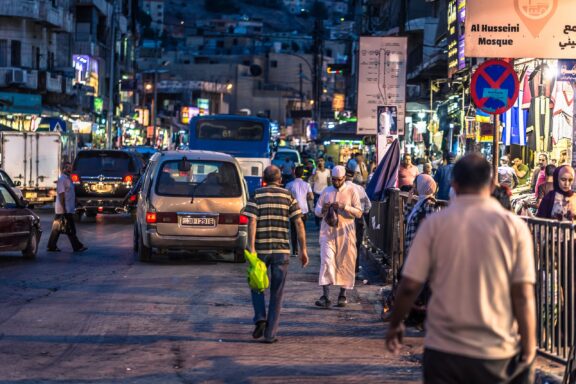
Amman is a melting pot of cultures and ethnicities, owing mainly to its history as a refuge for people affected by regional conflicts. The city is home to a significant Palestinian population and smaller communities of Iraqis, Syrians, and people from various other countries.
The population of Amman is estimated to be over 4 million, making up a significant portion of Jordan’s total population. The diversity is also reflected in religious practices; while the majority are Sunni Muslims, there are Christian communities and other minority religious groups.
Economy
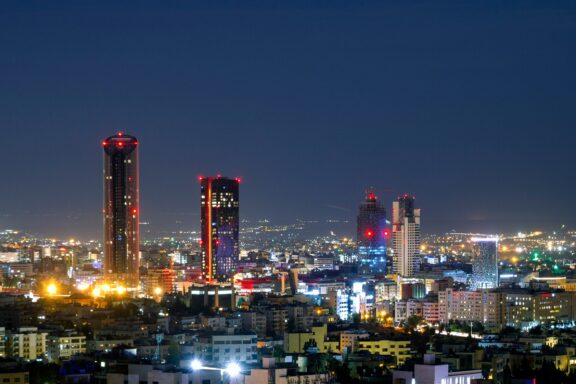
As Jordan’s capital and largest city, Amman is the country’s economic engine. It is a center for banking, retail, construction, and tourism. Various international companies have regional offices in the city, and it serves as a hub for start-ups and innovation.
Amman’s economy is also supported by expatriates who send remittances, injecting valuable foreign capital. Tourism is crucial, with visitors drawn to the city’s historical landmarks and modern amenities.
Despite regional instability and challenges such as unemployment, Amman remains economically resilient, demonstrating an ability to adapt and grow.
Things to Do and Places to See in Amman
Amman offers an extensive range of activities and sights to explore. Here’s an overview of the city’s most sought-after attractions and experiences.
1. Visit the Amman Citadel
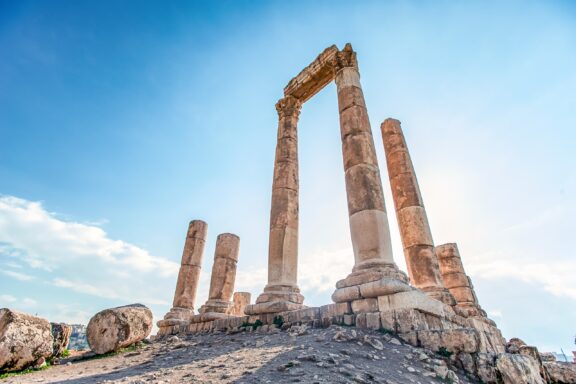
Perched on Jabal al-Qala’a, a hill overlooking Amman, the Amman Citadel offers a window into the multiple civilizations that have left their mark on the city. A site of historical and archaeological importance, the citadel draws visitors to explore the layers of Amman’s rich past.
The Amman Citadel complex houses various ruins, including fortifications, archaic temples, and Umayyad palace structures. The area also boasts sweeping city views, allowing for a greater understanding of Amman’s urban geography. Olive trees, local flora, and pathways connect the site’s key landmarks.
2. Explore the Roman Theater
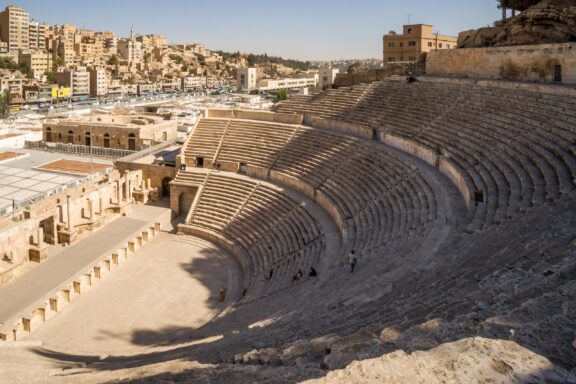
This steeply raked amphitheater is cut into the side of a hill and divided into three horizontal sections for different social classes. It has an orchestra section at the bottom and a stage backdrop that was originally a two-story building. Close to the theatre are two small museums holding a Jordanian and Roman artifacts collection.
Besides exploring this historical marvel, tourists can also catch live performances occasionally held here. The two adjoining museums enrich the visit, giving context to the theatre’s history and the region’s heritage.
3. Try Jordanian Cuisine at Local Restaurants
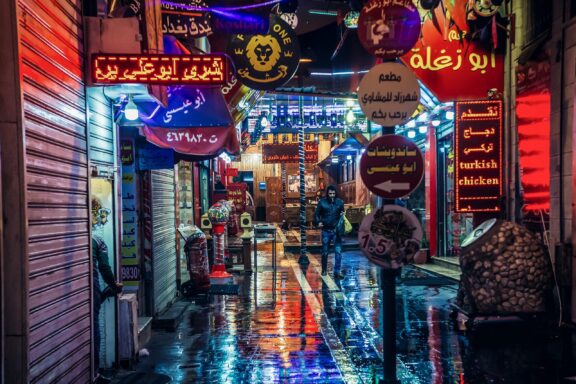
When you’re in Amman, you won’t want to miss out on the culinary delights that offer an authentic taste of the country’s rich heritage. Jordanian food is a beautiful amalgamation of Middle Eastern and Mediterranean flavors, featuring an array of herbs, spices, and sumptuous dishes. Here are some of the top places you can dine to experience local culinary delights:
- Sufra Restaurant: Located on Rainbow Street, this restaurant is celebrated for its traditional Jordanian dishes like Mansaf. It offers indoor and outdoor seating and is known for its inviting atmosphere.
- Hashem Restaurant: Situated in Downtown Amman, Hashem is renowned for its simple yet delicious street food like falafel and hummus. It’s a budget-friendly option and operates 24/7.
- Al-Quds Restaurant: Found on Al-Malek Al-Hussein St, Al-Quds specializes in meats, mainly stuffed lamb. It’s favored for its authentic flavors and quick service.
- Tawaheen Al-Hawa: Located on Wasfi Al-Tal Road, this family-friendly restaurant boasts various Jordanian dishes, including Mixed Grill and Zarb. The establishment offers a spacious environment adorned with traditional decor.
4. Visit the King Abdullah Mosque

The King Abdullah Mosqu is particularly notable for its expansive outdoor plaza and ornate interior, which includes beautiful Islamic calligraphy and intricate tilework. Visitors can explore the main hall and smaller side chambers that exhibit various Islamic art pieces and scriptures.
The mosque is not just for religious observers. It offers a compelling insight into Islamic architecture and Jordanian culture. Non-Muslim visitors are also welcome, and guided tours are available to explain this sacred space’s architectural and spiritual aspects.
5. Shop at Souk Al Bukharia
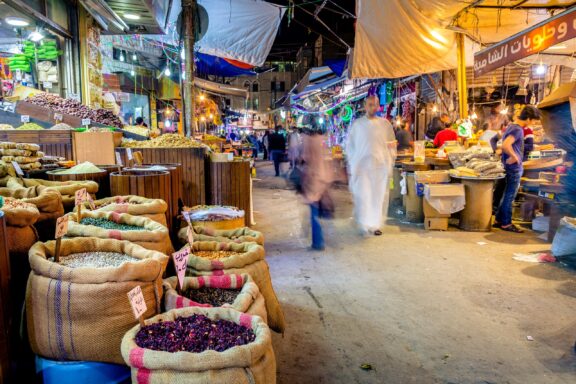
Souk Al Bukhari is a labyrinthine marketplace in the heart of Amman, embodying the traditional Middle Eastern shopping experience. With a maze of narrow lanes filled with stalls, Souk Al Bukharia offers a wide range of goods.
From textiles and clothing to local spices and handcrafted souvenirs, the marketplace is a kaleidoscope of colors, scents, and sounds. Visitors can bargain for unique gifts, sample local snacks, and soak up the lively atmosphere. The Souk offers an authentic and enriching experience for those wanting to delve into Jordanian daily life.
6. Dive into the Jordan Archaeological Museum
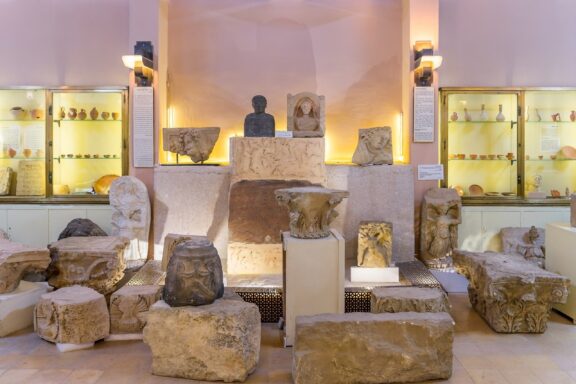
The Jordan Archaeological Museum offers a scholarly exploration of the country’s expansive history in the Amman Citadel complex. The Jordan Archeological Museum houses different artifacts from various periods. It features pottery, sculptures, and coins, all carefully labeled and organized.
This museum offers a comprehensive overview for those interested in a deep dive into Jordan’s archaeological timeline. It’s an educational stop that contextualizes the ancient sites around Amman.
7. The Jordan Museum
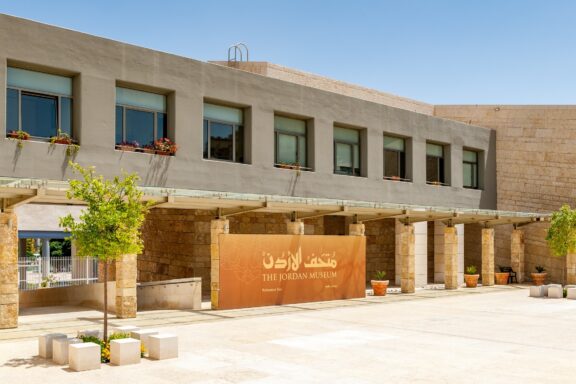
The Jordan Museum’s well-curated exhibitions span multiple subjects, from anthropology and folklore to the natural history of Jordan. High-tech displays and interactive installations make it a modern, engaging experience for visitors of all ages.
The Jordan Museum offers a well-rounded understanding of Jordan as a nation, making it a must-visit for anyone keen on grasping the multifaceted character of the country.
8. Grand Husseini Mosque
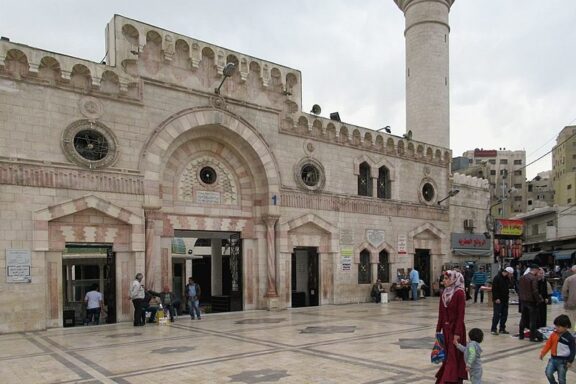
The Grand Husseini Mosque stands as a spiritual cornerstone amid downtown Amman. The mosque features a simple yet elegant design, with a large prayer hall and a minaret. It serves as a religious center and a communal gathering point, resonating with community and spirituality.
Open to visitors of all faiths, the mosque offers an opportunity to experience Islamic worship and community up close. It’s also an excellent place to observe the architectural subtleties of Islamic design.
9. King Hussein Mosque
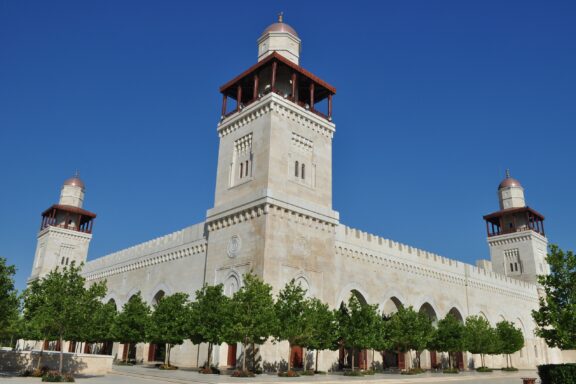
The mosque features a modern Islamic architectural style with intricate tilework and an imposing minaret. It houses a large prayer hall and offers various community services, solidifying its role as a central institution in Amman.
Apart from its religious significance, King Hussein Mosque offers visitors a glimpse into contemporary Islamic architecture and the evolving face of Amman’s community.
10. Visit the Royal Automobile Museum
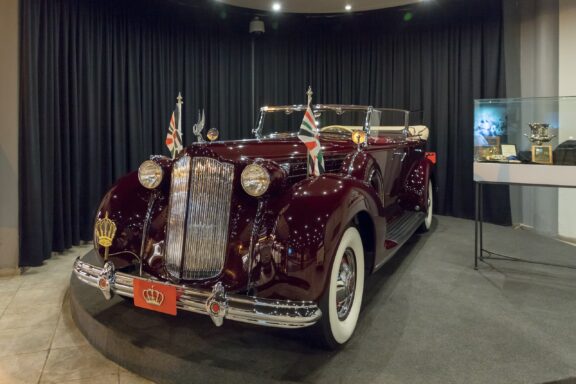
The Royal Automobile Museum in Amman is a tribute to the history of transportation and its role in shaping Jordan’s modern era. The museum boasts a diverse collection of vehicles, ranging from vintage cars to modern sedans, each with historical context.
Car enthusiasts and history buffs alike will find the museum engaging. With carefully curated exhibits and detailed descriptions, the museum offers a nostalgic journey through time set on wheels.
11. Take a Trip to Qasr al-Abd
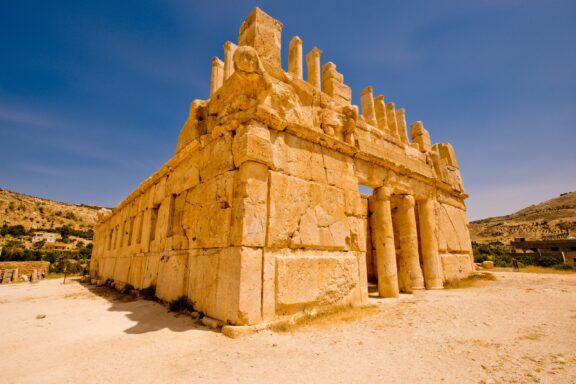
The Ruins of Qasr al-Abd are located around 20 km away from Amman, near the village of Iraq al-Amir. This ancient structure is shrouded in mystery and intrigue, sparking the curiosity of archaeologists and tourists alike.
Constructed from massive limestone blocks, the ruins feature ornate carvings and remnants of walls and arches. Although the structure’s original purpose is still debatable, it stands as a testament to the sophisticated craftsmanship of ancient builders.
Qasr al-Abd offers a captivating visit for those interested in archaeology and ancient history. The ruins are set against a picturesque landscape, making it a serene spot for exploration and photography.
Frequently Asked Questions
Is Amman safe for tourists?
Generally, Amman is considered safe for tourists. Like any large city, taking standard safety precautions is always wise, but violent crime is rare. The Jordanian people are generally welcoming and hospitable to visitors.
What is the traditional cuisine like in Amman?
The traditional cuisine of Amman is primarily influenced by Bedouin cooking, which features hearty meat dishes, and Levantine cuisine, known for its variety of mezze or appetizers.
The food has been shaped by centuries of trade, migration, and the availability of locally grown ingredients like olives, lemons, and garlic. Grilled meats, fresh vegetables, and various spices, including cumin, coriander, and sumac are commonly used.
What are must-try authentic local dishes in Amman?
If you’re looking to delve into authentic local cuisine, there are a few dishes you absolutely must try in Amman:
• Mansaf: This is the national dish of Jordan, consisting of lamb cooked in fermented, dried yogurt and served over rice.
• Falafel: A deep-fried chickpea patty often served with tahini, salad, and pickles on pita bread.
• Maqluba: An “upside-down” dish of rice, vegetables, and meat cooked together and then flipped onto a serving platter.
• Kanafeh: A popular dessert made with thin noodle-like pastry soaked in syrup, layered with cheese, and then baked.
Are there any cultural customs I should acknowledge while in Amman?
In Amman, greeting people with a handshake is customary, often accompanied by a touch on the shoulder. When entering a mosque or home, removing your shoes is polite.
Being overly affectionate in public, like hugging and kissing, is generally frowned upon, especially between members of the opposite sex. It’s common to offer and accept items with the right hand only, as the left is considered impolite for such interactions.
What is the best time to visit Amman?
The best time to visit Amman is spring (March to May) and autumn (September to November) when the weather is mild and pleasant. Summers can be hot, while winters are generally cool and wet.
What currency is used in Amman?
The Jordanian Dinar (JOD) is the currency used in Amman. Credit cards are widely accepted in hotels and larger establishments, but carrying some cash for smaller shops and markets is a good idea.
Do people speak English in Amman?
English is widely understood in Amman, especially in areas frequented by tourists. Most signs are in both Arabic and English. However, learning a few basic phrases in Arabic can enrich your experience.
How do I get around Amman?
Amman has various transportation options, including buses, taxis, and ride-sharing services. The city is also walkable in certain areas, although the hilly terrain can be challenging.
What type of electrical outlets are used in Amman?
Jordan uses British-style Type G electrical sockets. The standard voltage is 230 V, and the standard frequency is 50 Hz. Travelers may need a plug adapter or voltage converter.
Is there a dress code in Amman I should be aware of?
While Amman is relatively liberal compared to some Middle Eastern cities, it’s advisable to dress modestly, especially when visiting religious or traditional sites.
Are there vegetarian food options?
Yes, Middle Eastern cuisine offers a variety of vegetarian options like hummus, falafel, and tabbouleh.
Final Thoughts
Amman is a city that offers a unique blend of ancient history and modern vitality. It serves as a gateway to understanding Jordan and the broader Middle East while also standing as a fascinating destination in its own right.
With its rich tapestry of cultures, engaging historical landmarks, and welcoming atmosphere, the city offers a rewarding experience for travelers of all kinds. It’s a city where tradition and modernity coexist harmoniously, making it a destination that is not just worth visiting, but truly unforgettable.
Image Sources and Copyright Information
- Political Map of Jordan: © Peter Hermes Furian/Shutterstock
- Location Pin on Amman, Jordan Map: © JoaoCachapa/Shutterstock
- Ancient Roman Nymphaeum Ruins in Amman: © Aleksandar Todorovic/Shutterstock
- Umayyad Palace Ruins at Sunset: © Georgios Tsichlis/Shutterstock
- Old Railway Station Building with People on Platform: © Freedom's Falcon/Wikimedia | CC BY 3.0 Unported
- Night View of a Tree-Lined Boulevard in Amman: © Thiago B Trevisan/Shutterstock
- Aerial View of Amman with Flag: © nayef hammouri/Shutterstock
- Evening Bustle in Amman City Center: © RPBaiao/Shutterstock
- Amman Skyline at Night: © Ayman alakhras/Shutterstock
- Ancient Columns of the Temple of Hercules at Amman Citadel: © Ralf Siemieniec/Shutterstock
- Narrow Alley in Amman at Night with Neon Signs: © Fotokon/Shutterstock
- King Abdullah Mosque under blue sky: © Georgios Tsichlis/Shutterstock
- Bustling Market Scene with Sacks of Spices and Goods: © Georgios Tsichlis/Shutterstock
- Museum Interior with Ancient Artifacts Display: © NavinTar/Shutterstock
- Exterior View of The Jordan Museum Building: © Anton_Ivanov/Shutterstock
- Facade of the Grand Husseini Mosque with People Gathering Outside: © D-Stanley/Wikimedia | CC BY 2.0 Generic
- King Hussein Mosque Exterior View: © Ahmad A Atwah/Shutterstock
- Vintage Car Display at Royal Automobile Museum in Amman: © Dmitriy Feldman svarshik/Shutterstock
- Ancient Stone Ruins Under Clear Sky: © Anton_Ivanov/Shutterstock